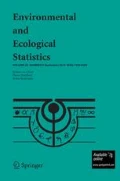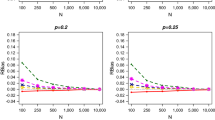Abstract
In a recent article Rehman et al. (Environ Ecol Stat 23:623–638, 2016) proposed a “novel, non-parametric, frequentist approach for capture–recapture data”. The supposed advantages of the method include the lack of parametric assumptions, the ability to include clustered samples, accounting for the order of observations, the efficiency of the asymptotic variance of the estimator and how large a sample is required for the estimator to be approximately unbiased (referred to as the rate of convergence in the article). We consider these claims, comparing the estimator of Rehman to that proposed by John Darroch in the 1950s. Rehman’s estimator is unable to improve upon Darroch’s either theoretically or practically.
Similar content being viewed by others
Notes
Our notation for \(\omega \) differs from that of Darroch (1958).
We have made minor changes to the notation of Rehman et al. (2016).
The original manuscript has \(Bern(y_{i}/\nu )\) which we believe to be in error. The change we have made has a follow on effect to the proposed estimator for \(\nu \).
References
Barker RJ, Schofield MR, Wright JA, Frantz AC, Stevens C (2014) Closed-population capture–recapture modeling of samples drawn one at a time. Biometrics 70:775–782
Chao A (1987) Estimating the population size for capture–recapture data with unequal catchability. Biometrics 43:783–791
Cormack RM (1964) Estimates of survival from the sighting of marked animals. Biometrika 51(3/4):429–438
Darroch JN (1958) The multiple-recapture census: I. Estimation of a closed population. Biometrika 45:343–359
Darroch JN (1959) The multiple-recapture census: II. Estimation when there is immigration or death. Biometrika 46:336–351
Darroch JN, Ratcliff D (1980) A note on capture-recapture estimation. Biometrics 36:149–153
Hwang WH, Chao A, Yip PSF (2002) Theory & methods: continuous-time capture–recapture models with time variation and behavioural response. Australian N Z J Stat 44(1):41–54
Jolly GM (1963) Estimates of population parameters from multiple recapture data with death and dilution—deterministic model. Biometrika 50:113–128
Jolly GM (1965) Explicit estimates from capture–recapture data with both death and immigration-stochastic model. Biometrika 52(1/2):225–247
McCrea RS, Morgan BJT (2014) Analysis of capture–recapture data. CRC Press, Boca Raton
Otis DL, Burnham KP, White GC, Anderson DR (1978) Statistical inference from capture data on closed animal populations. Wildl Monogr 62:1–135
Pledger S (2000) Unified maximum likelihood estimates for closed capture–recapture models using mixtures. Biometrics 56:434–442
Rehman Z, Toms CN, Finch C (2016) Estimating abundance: a non parametric mark recapture approach for open and closed systems. Environ Ecol Stat 23:623–638
Schofield MR, Barker RJ (2016) 50-year-old curiosities: ancillarity and inference in capture–recapture models. Stat Sci 31:161–174
Schofield MR, Barker RJ, Gelling N (2017) Continuous-time capture-recapture in closed populations. Biometrics (in press)
Seber G (1962) The multi-sample single recapture census. Biometrika 49:339–49
Seber GAF (1965) A note on the multiple-recapture census. Biometrika 52(1/2):249–259
Seber GAF (1982) The estimation of animal abundance and related parameters, 2nd edn. MacMillan Publishing, New York
Wilson RM, Collins MF (1992) Capture–recapture estimation with samples of size one using frequency data. Biometrika 79:543–553
Author information
Authors and Affiliations
Corresponding author
Additional information
Handling Editor: Bryan F. J. Manly.
This comment refers to the article available at DOI 10.1007/s10651-016-0357-8.
Rights and permissions
About this article
Cite this article
Schofield, M.R. Comment: Estimating abundance: a non parametric mark recapture approach for open and closed systems. Environ Ecol Stat 24, 587–594 (2017). https://doi.org/10.1007/s10651-017-0382-2
Received:
Revised:
Published:
Issue Date:
DOI: https://doi.org/10.1007/s10651-017-0382-2




